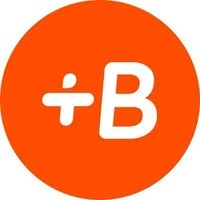Best For | Best for busy learners wanting quick, practical language skills on a budget. | Best for immersive learners seeking deep fluency with flexible, long-term practice. |
Price | $9.95/mo (Billed for 3 months) | €14.95/mo (Billed for 3 months) |
Features | Short, practical lessons. | Immersive language method. |
Pros | Affordable for beginners. | Builds strong fluency. |
Cons | Limited advanced content. | Higher cost overall. |
Learning a new language is exciting, but choosing the right program can be tricky. Two of the biggest names out there are Babbel Vs Rosetta Stone. Both promise to help you speak a new language, but they work in different ways.
I’ve tried both, and here’s what I found: Babbel feels more practical, focusing on real-life conversations. Rosetta Stone, on the other hand, teaches you by total immersion—no translations, just the language itself. Some people love this; others find it frustrating.
So, which one is better for you? That depends on how you like to learn. In this guide, I’ll compare their features, pricing, and effectiveness to help you decide.
Let’s find out which program fits your learning style best!
Babbel Vs Rosetta Stone 2025– Learn New Language
Let’s have an overview of these platforms first.
What is Babbel?
It offers 14 languages in its paid language learning app, Babbel. With Babbel, you can practice basic language skills for beginners, such as grammar, vocabulary, and phrases.
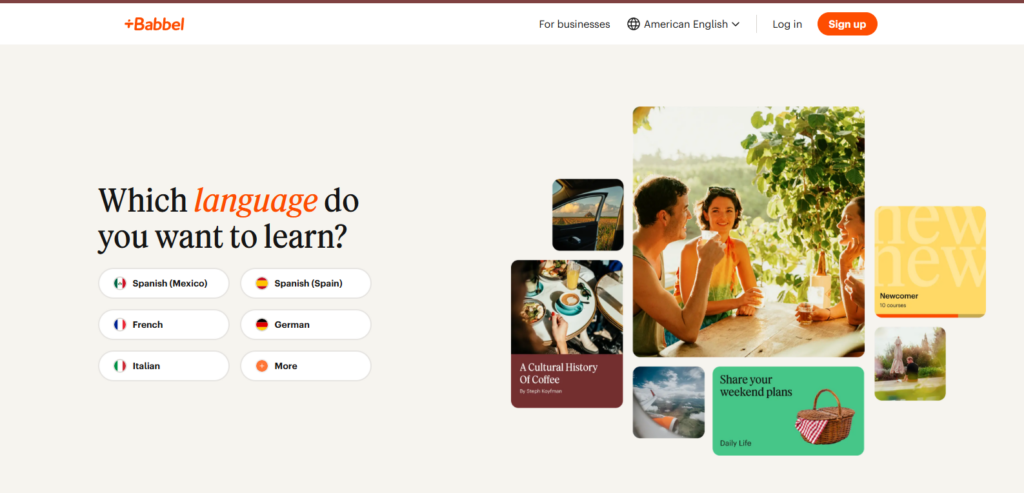
The Babbel vs Rosetta Stone showdown often comes down to affordability, with Babbel being notably cheaper.
Babbel requires separate plans for each language, but you can pay monthly, quarterly, semi-annually, or for a lifetime for all languages. Each lesson integrates listening, writing, and speaking, with English grammar explanations and frequent review drills.
Strengths in Babbel vs Rosetta Stone: Babbel is praised for clear explanations, affordable plans, concise grammar tips, and practical conversation-based learning.
What is Rosetta Stone?
Also available via desktop, tablet, and mobile devices, Rosetta Stone is a paid instructional program.
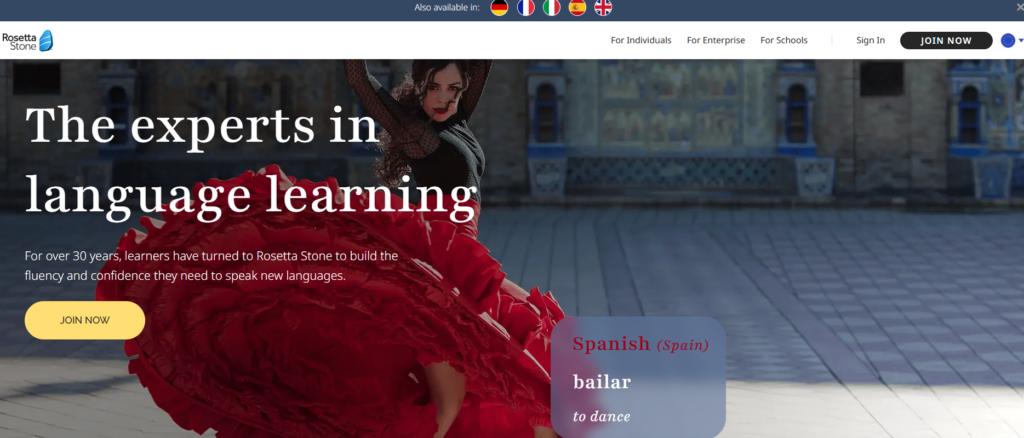
From a branding perspective, it’s the more well-known name in the English-speaking world since it has been around for so long (back in CD-Rom days!). In 1992, a US entrepreneur founded a brand based on Egyptian hieroglyphics.
Rosetta Stone excels for learners who thrive on immersion and visual cues, aiming for long-term fluency.
How Babbel Works?
Here’s how Babbel works for a new user trying to get started.
1. Decide which language you would like to learn
The process begins by choosing which language you want to learn, and you’ll be directed to a course that fits your needs. Moreover, you must pay separately for Spanish and English to learn both languages.
2. Pass the proficiency placement test
Babbel asks five different questions to determine your proficiency level in a language. The lessons inside the language course seem to have the same format but are specifically chosen to determine your language skills.
3. Upgrade your subscription to a paid one
After completing your first trial lesson, you’ll be prompted to choose a paid plan. The company offers four different plans as of 2018, including a monthly plan, 3-month plan, 6-month plan, and 12-month plan. You must pay upfront for any payment plan other than the one-month plan.
How Rosetta Stone Works?
1. Take a look at their interactive demonstration
Rosetta Stone’s onboarding process seems to be less transparent than Babbel’s. They offer a free interactive demo with four free lessons so you can see how the lessons work. The user experience appears to be similar to Babbel’s at first glance.
2. Subscriptions are available on CD-ROM or online
There are two types of Rosetta Stone software: a CD-ROM version that can be downloaded instantly and a subscription service that expires once you cancel it. Online subscription products seem relatively new, considering the evolution of technology in recent years.
In both options, there are advantages and disadvantages. CD-Rom licenses may be kept forever, and 5 users are allowed. The mobile app and games & activities features are only available for a 3-month trial.
3. Upgrade to a Pricing Plan
Rosetta Stone’s cloud version is likely to interest most people. Let’s explore its pricing. Rosetta Stone’s pricing structure requires separate subscriptions for each language, similar to Babbel’s.
They have identical prices for all languages but are approximately twice as expensive as Babbel. Rosetta Stone may have better brand recognition and invested more into their curriculum and technology, but the choice is yours.
4. Business Model
Additionally, Rosetta Stone and Babbel have slightly different business models. Since Rosetta Stone started offering subscriptions, however, the trend has shifted. In addition to their standard model, Rosetta Stone offers a version that can be downloaded instantly.
The prices for Rosetta Stone on CD-ROM are as follows:
- Level 1: $179
- 2 levels: $279
- 3 levels: $379
- Full 5 levels: $479
The time required to complete each level can certainly add up since Rosetta Stone estimates it takes around 40-50 hours per level.
If you choose to purchase these separately after completing the very basic beginner level in a month, you will have to invest another $179.
5. Specialty
In both apps, the focus is on teaching basic vocabulary and grammar rules. Babble claims to help you with conversation skills more than Duolingo. Rosetta Stone offers live tutoring as an upsell for those wishing to book private video lessons.
How Languages Are Taught On Each Platform?
Babbel
It’s okay to start with Babbel’s lessons, but they’re not special. Many, if not all, of the things they do are available elsewhere.
You’ll start by hearing a speaker read the words you must master with images beside them. Your grade will be based on the accuracy of how you pronounce the words after listening and repeating them.
However, the technology isn’t advanced enough to ensure your pronunciation will be accurate, so you cannot rely on it to tell you if you are speaking correctly.
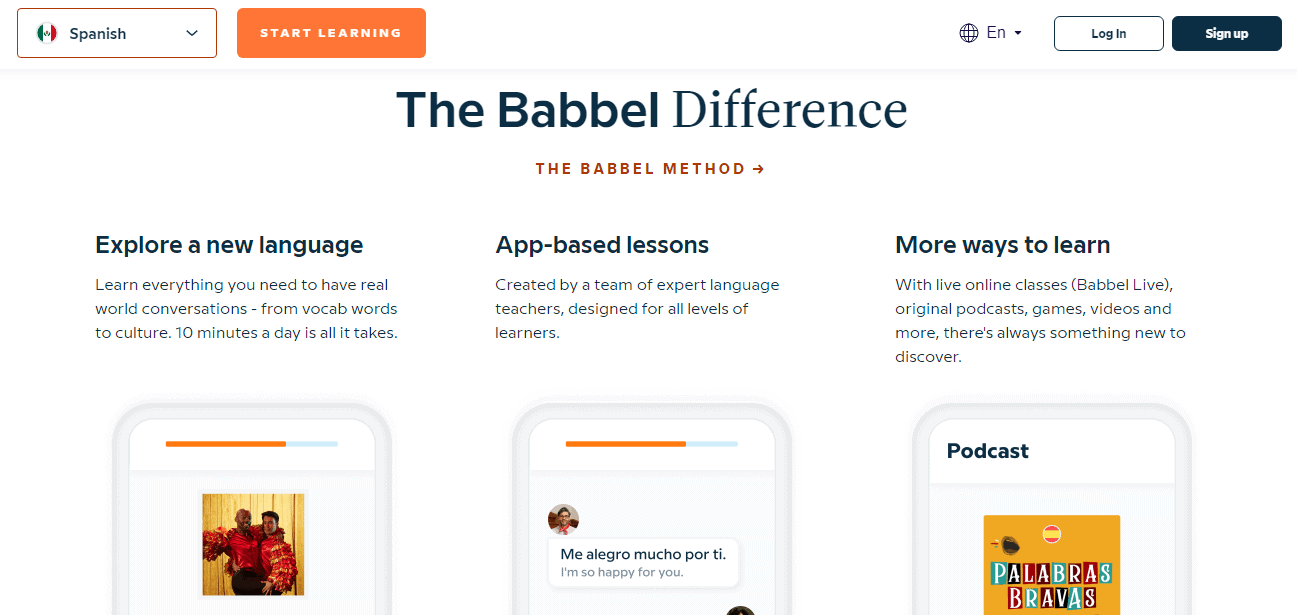
I recommend finding a tutor on Italki who can give you good feedback on your speaking – they usually charge less than $10/hour.
The translations will then be matched to the pictures. Then, you’ll use the mixed-up letters given to you to translate each image.
The repetition of these exercises is helpful even if they aren’t exciting. This leads to the formation of sentences and, finally, a dialogue.
To complete the sentence, you’ll need to provide the right word. Because the letters are mixed up, it’s pretty easy. The dialogues feel natural, as if they were real-life conversations. It’s also quite clear and of good quality audio.
Grammar lessons are complemented by pop-up notes that explain certain key points for a better understanding. This is a significant advantage over Rosetta Stone.
Grammar isn’t exciting, but when you learn it, it makes things so much easier. Each lesson ends with a review exercise. Babbel’s strength is not in being innovative in any way. In their place, they offer clear explanations, well-structured courses, and multiple ways to practice the material.
Rosetta Stone
Rubbel’s lessons aren’t the most interesting or varied, and Rosetta Stone’s even less so. Rosetta Stone uses almost exclusively your target language, which sets it apart from other language learning courses.
Immersion is fundamental to them, and you should do the same. In general, I think this is a bad idea. Adults are much different than young children. Our advantages make language learning easier than it needs to be for children, and ignoring them makes it more difficult.
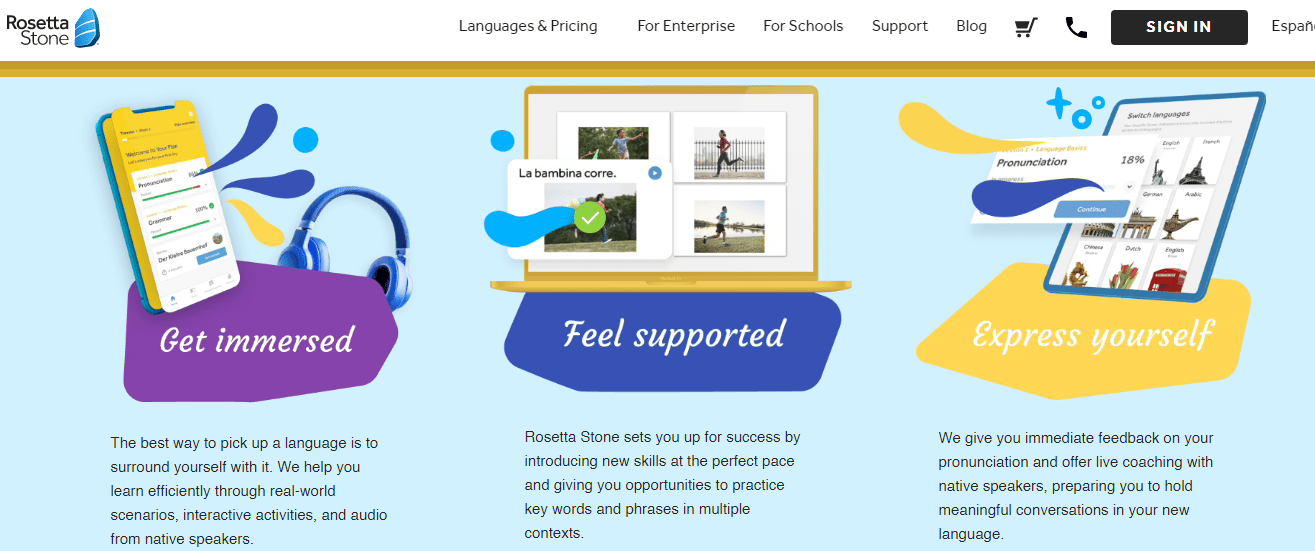
The lessons on the Rosetta Stone, while they include various skills such as listening and writing, are very repetitive regardless of the content. Using the Rosetta Stone amounts to a long stream of matching pictures to words or sentences.
You can use this to teach a lot of vocabulary and a few simple grammar points. However, pictures alone cannot explain all the vocabulary. Grammar is even more complicated.
This method may help understand some simple grammar points, but learning complex grammar will likely bewilder the learner. The learner could benefit from a quick explanation in English.
Each picture is accompanied by audio, and they use different speakers and high-quality audio. The app also contains useful writing exercises.
In a similar way to Babbel, I appreciate the fact that they encourage you to practice speaking and use voice recognition software.
However, Rosetta Stone’s voice recognition software is not that great either. To gauge your pronunciation, it would not be advisable to rely on it alone. Rosetta Stone has a major flaw: its lessons are repetitive.
The platform could easily bore learners and eventually lead to them giving up on learning a language. Additionally, removing translations is not worth the tradeoffs, in my opinion.
Doing this might make you feel less compelled to perform translations in your head. It doesn’t matter if you need to translate in your head when you first start – you’ll eventually get better at automatically recalling words as you improve.
Leaving out English explanations makes learning a language much easier versus the short-term gains associated with avoiding translations.
Babbel Vs Rosetta Stone: Pricing Comparison
Babbel Pricing
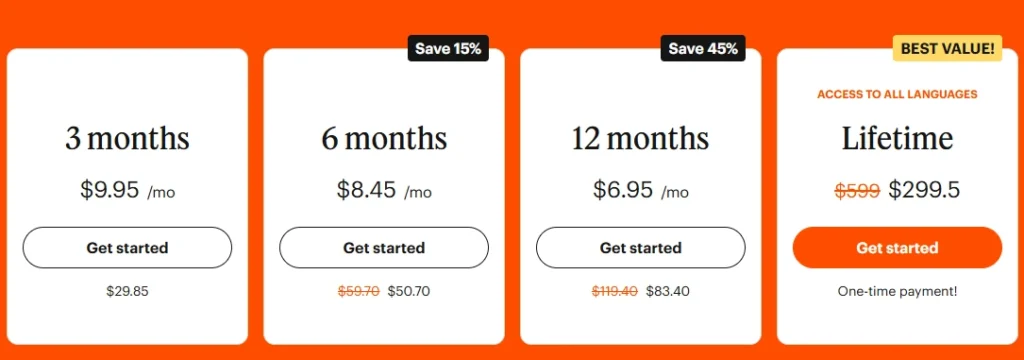
- 3-Month Plan: $9.95 per month ($29.85 total)
- 6-Month Plan: $8.45 per month ($50.70 total) – Save 15%
- 12-Month Plan: $6.95 per month ($83.40 total) – Save 45%
- Lifetime Access: One-time payment of $299.50 (regular price $599) – Unlimited access forever!
These plans give you full access to all the languages on Babbel. 🚀
Rosetta Stone Pricing
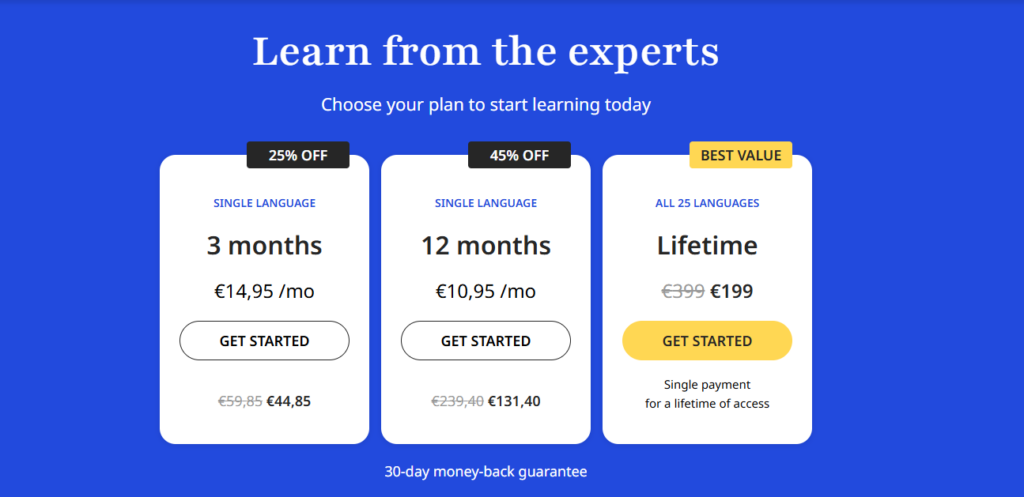
- 3-Month Plan: €14.95 per month (€44.85 total)
- 12-Month Plan: €10.95 per month (€131.40 total)
- Lifetime Access (All 25 Languages): €199 (one-time payment) – Regular price €399
With these plans, you can choose your preferred language (e.g., Spanish, French, German) and start learning right away! 🚀 Babbel’s plans are more budget-friendly for most users. However, Rosetta Stone’s all-language lifetime access is a solid investment, especially for polyglots.
Quick Links:
Babbel vs Rosetta Stone: FAQs
Q1: Which is better for learning quickly—Babbel vs Rosetta Stone?
A: Babbel is often better for fast, practical language skills, while Rosetta Stone is best for immersive, long-term fluency.
Q2: Does Babbel vs Rosetta Stone offer live tutoring?
A: Rosetta Stone offers live tutoring as an add-on. Babbel currently does not include live tutors but provides comprehensive self-guided lessons.
Q3: Can you try Babbel vs Rosetta Stone for free?
A: Both apps offer free trial lessons, so you can sample the content and features before subscribing.
Q4: Which app includes more languages—Babbel vs Rosetta Stone?
A: Rosetta Stone offers 25 languages compared to Babbel’s 14.
Q5: Does Babbel vs Rosetta Stone work better for grammar?
A: Babbel’s English grammar notes make it a better option for learners who need structured guidance.
Final Thoughts: Babbel Vs Rosetta Stone 2025
The Babbel vs Rosetta Stone comparison boils down to your learning style, budget, and language goals.
Babbel is excellent for learners needing quick, clear, and practical progress on a budget, with strong support for grammar and daily conversation. Rosetta Stone is best for immersive, repetition-based learners who want to achieve long-term fluency and can invest more time and money.
I would choose Babbel if I had to choose. The price is slightly lower, but the lessons are more varied.
Since they include English grammar explanations, you will be less anxious and less likely to make mistakes.
Nonetheless, I recommend exploring what else is available in the language you’re learning before choosing either of these courses using the links below.

